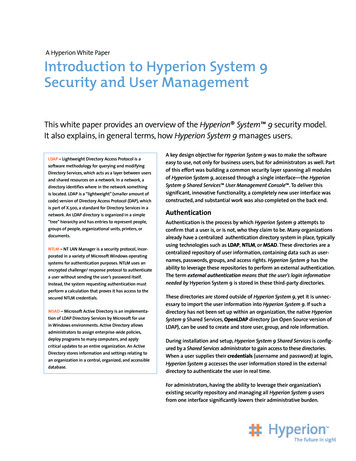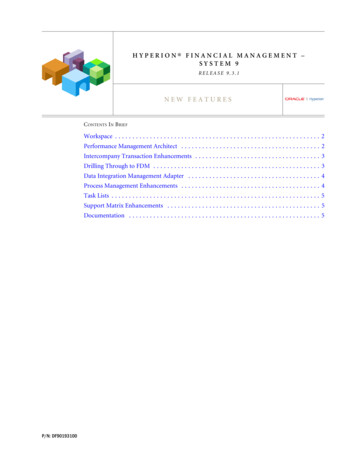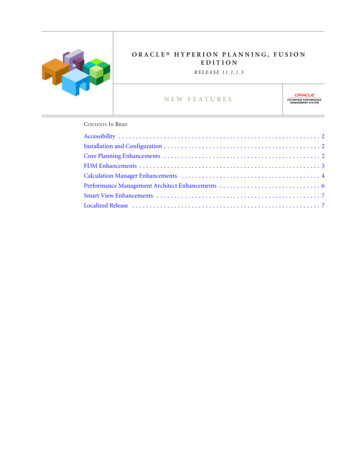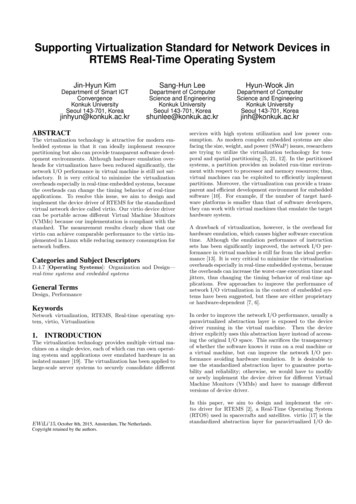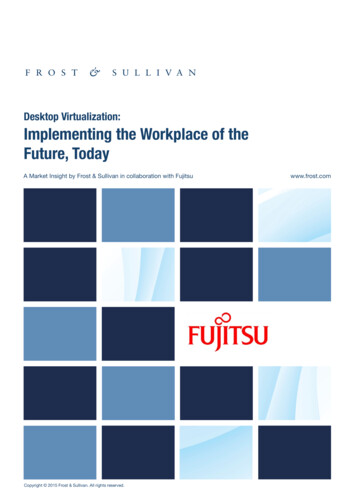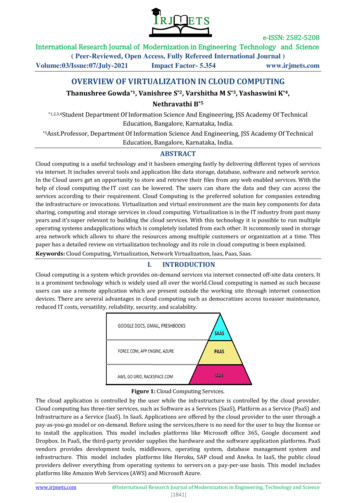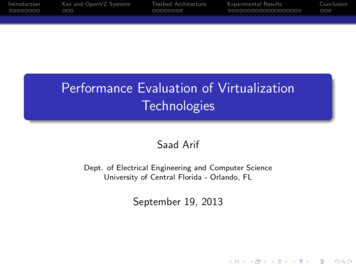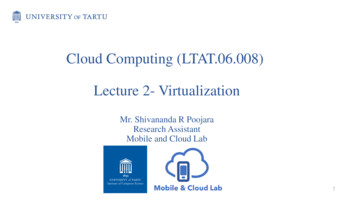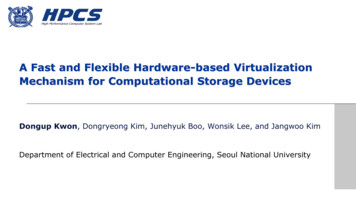
Transcription
Oracle Hyperion FinancialManagement VirtualizationWhitepaper
Oracle Hyperion Financial Management Virtualization WhitepaperTABLE OF CONTENTSOverview . 3Benefits . 4HFM Virtualization testing . 5HFM 11.1.1 test results . 5HFM 11.1.2 test results . 5Summary . 6HFM Customer application deployment case studies . 7Conclusions . 9Appendix . 10Virtual Machine Environment Configuration . 10Oracle Hyperion Financial Management Virtualization WhitepaperPage 2
Oracle Hyperion Financial Management Virtualization WhitepaperOVERVIEWThe purpose of this document is to explain the usage and benefits of virtualization technologies onan Oracle Hyperion Financial Management (HFM) deployment. This document is not intended tobe a source of best practices nor a recommendation for application deployment. It is intended toprovide a solid foundation of technical information regarding virtualization deployment solutions.Virtualization has become a key technology,enabling organizations to deploy their enterpriseapplication more quickly and manage it more efficiently. With multiple virtual machines runningon a single set of hardware, it supports scalable, highly efficient and lower-cost deployments.Historically, and typically, virtualized environments were ideal for Development or Testenvironments. Simple reinstallation by re-deploying a formerly saved image or template after eachtest run is a key driver for these test environments. However, many Production environments arebeginning to take advantage of virtualization.When deciding on the environment configuration, many customers tend to separate the Productionenvironment from the Test environment. In a typical Production environment configuration,dedicated clusters and servers are used to ensure that specified resources (CPU and RAM) areguaranteed at the individual server level. During peak loads, additional resources can be allocatedand managed to ensure maximum performance and utilization.In most cases, the Production environment would have active load balancing with 100% full serverredundancy. In a typical Test environment, since high availability is seldom needed, a shared singlephysical server with no redundancy may be sufficient.Various system virtual machine software solutions are available in the market now. Among themare Oracle VM, VMware, and Microsoft Virtual Server, all providing virtualization technology.Oracle VM is a leading server virtualization software supporting both Oracle and non-Oracleapplications. Oracle VM is the only software based virtualization solution that is fully supportedand certified for Oracle Real Application Clusters.Oracle Hyperion Financial Management Virtualization WhitepaperPage 3
BENEFITSIn most virtualization environments there are fewer large physical machines with ample amountsof memory used to configure many virtual machines. This allows for full leverage of the investmentmade in the computer hardware by consolidating multiple servers as separate virtual machines.The cost savings associated with having fewer physical servers is an important benefit.Ease of installation and configuration from one virtual server to another simplifies maintenance,reduces IT complexity and minimizes IT support resources.By allowing multiple operating systems to run concurrently on a host computer, the potentialproblem of interference when different services are run separately is avoided.During peak loads, additional resources can be allocated from one server to another to guaranteemaximum performance and utilization. In the typical Hyperion Financial Management applicationenvironment, most HFM customers are heavy peak users during their financial closing cycle.Therefore they can easily allocate additional resources from one virtual server to another duringpeak load to maximize performance and concurrent usage. The ease of resource reallocation in avirtual environment is a major benefit for HFM users.Rapid provisioning allows for reduction in deployment time. Deployment templates are often usedto simplify the deployment process. It also can respond more rapidly to business changes. Theincrease in ROI will also reduce lifetime total cost of ownership.With Server Consolidation in virtualization, fewer physical servers need to be backed-up andreplicated on a regular basis. Complete backups can be managed on a daily basis while full disasterrecovery can easily be done in a short period of time. This provides a faster backup procedure anda simpler, more reliable recovery process of critical applications.Virtualization is not simply an extension of physical infrastructure but instead can bring a host ofextra benefits to data protection. This is extremely important for HFM applications as HFM is a datasensitive application where prompt and reliable disaster recovery process is mission critical.Virtualization provides the extra benefits to data protection needed for the HFM customers.Oracle Hyperion Financial Management Virtualization WhitepaperPage 4
HFM VIRTUALIZATION TESTINGTo ensure that Hyperion Financial Management will also take advantage of the benefits offered invirtualization, various testing was done using both the HFM 11.1.1 release and HFM 11.1.2 release.HFM 11.1.1 TEST RESULTSThe first test set was done by configuring an HFM application to run under the Oracle VMenvironment. The test was completed by deploying one physical server with 4-CPU hosting twoOracle Virtual Machines –Windows 2003 and Linux server – each configured with 4 GB RAM.Testing features included Data Load, Journals, Web Grid, Web Form, Financial Report andconsolidation. Various processes were invoked for duration of 5 hours to ensure that the target of40 concurrent users was reached before the next iteration began.The target CPU usage was at 75% to 80% with 40 concurrent users mark. Increasing theconcurrent users to 50 increased the CPU usage to 90% . Hence, to avoid overloading the CPU, thetest was kept at the target CPU usage with the 40 concurrent users in the system.The test results showed that most of the tasks were performed within 1 to 3 seconds. Only a fewtasks took longer than 5 seconds to perform. The memory usage remained stable during the entiretest. A Windows VM with 4 GB memory was able to comfortably run 40 mixed-workload interactiveusers with CPU utilization within the 75% to 80% range.HFM 11.1.2 TEST RESULTSThe second test set was performed on a 2-tier EPM configuration over 2 physical servers. Bothservers were configured using OVM 2.2.1. The application server is a virtual server with 2 dualcore 64-bit CPU and 7GB of memory. The database server, hosting the Oracle DB 11gR2, is a virtualserver with 2 dual-core 64-bit CPU and 4 GB of memory.The HFM application used for testing was based on a customer application with 1000 entities and2000 accounts. Testing features included read and write operations on Web Form, Web Grid andConsolidation.There were 42 concurrent virtual users included as part of the testing process. The system was setwith pacing intervals and concurrency to represent a 100-user system. In a typical HFMapplication environment, a concurrent usage of 30-40% is expected. Therefore, the 42 virtual usertest mimicked a workload equivalent to a real-world 100-user system at peak time.The test results showed that HFM was able to perform properly with acceptable performanceunder the OVM environment. Memory usage was stable with acceptable throughput for the entireprocess. There is no functional regression under the OVM environment. (See Appendix for details)Oracle Hyperion Financial Management Virtualization WhitepaperPage 5
The virtual servers can be easily configured based on HFM customer’s IT policies and managementrequirements. The flexibility of reconfiguration to use more CPU / memory during peak loads tomaximize performance and concurrent usage is a major benefit for HFM users.SUMMARYBoth sets of test results confirmed that HFM applications were able to take advantage ofvirtualization technologies by running properly with a moderate number of concurrent userswithin an OVM environment. There is no functional regression using virtualization. The use ofvirtualization would definitely reduce the total cost of ownership for any HFM system. However, itis still possible to overload hardware by having too many users for the number of virtual machineswhich will degrade performance and efficiency to unacceptable levels.Oracle Hyperion Financial Management Virtualization WhitepaperPage 6
HFM CUSTOMER APPLICATION DEPLOYMENT CASE STUDIESAs the adoption of virtualization technology increases, enterprise’s of all sizes embracevirtualization to consolidate resources, increase server utilization and reduce the overall cost ofownership. Among the HFM customer application deployments, all have experienced the benefitsof major reductions in the physical server count and less need for IT support resources whilecontinuing to maximize business system uptime.One HFM customer Production environment uses 7 of their 15 virtual servers to maximizeperformance in one data center, while 5 virtual servers are used for both their Testing and DisasterRecovery environments at a different data center. If they had not used virtual servers, they wouldhave required 12 additional physical servers to support both the Production and Testingenvironments.In their virtualized environment they use dedicated VMware cluster with 3 dedicated ESX hostservers each with 64 GB RAM. Their Production Environment supports all Applications and Webtiers. CPU and RAM resources are guaranteed at each virtual server level. Additional resources areallocated during peak loads to maximize CPU and RAM utilization.Their key driver for virtualization was server scalability and high availability that would maximizebusiness performance while minimizing IT support.Another HFM customer implemented virtual machines for their Testing environment and savedapproximately 4200 / server for 6 servers with a total cost saving of 25,200. Going forward,their plan is to use virtual machines in all of the environments including Production, Testing andDisaster Recovery. A total of 20 virtual servers will be used with a projected cost saving of 84,000.Many other HFM customers have felt the push from their IT department for virtualization. Therationale for implementing a virtualized environment is no longer just for efficiency, serverconsolidation, disaster recovery and cost saving, it has become standard IT policy.One HFM customer has benefited from their standard IT policy to implement HFM and FDM v9.3.1running under VMWare for both of their Production and Testing environments with the sameconfiguration. Although they do not run a dedicated VM host for the Oracle EPM applications, theyhave not encountered any technical issues directly attributed to virtualization. They use VMWarevMotion for Load Balancing. For Disaster Recovery solution, they simply use block replication of allVMs to a secondary site. They recognized the flexibility provided from virtualization and claimedthat it would be as simple as just a click of a button to add more RAM as needed. Depending on theapplication, they will allocate the appropriate number of CPU and RAM to achieve maximumperformance. In the case of the HFM application, they only needed to allocate 2 CPUs and 8 GBOracle Hyperion Financial Management Virtualization WhitepaperPage 7
RAM which typically provided them more than 90-95% efficiency with regard to capacityutilization. This increased hardware efficiency is another part of the total cost savings along withthe administrative overhead reduction savings. Given their positive experience with virtualizationthey would highly recommend a virtualized approach to other HFM users.Oracle Hyperion Financial Management Virtualization WhitepaperPage 8
CONCLUSIONSAdoption of virtualization technology is expected to increase in future implementations. In a typicalEPM environment, HFM users can often take advantage of the simple reallocation of resourcesduring heavy peak load of their financial close cycle to achieve maximized efficiency. Data sensitiveapplications such as HFM application can surely benefit from the reliable disaster recovery processoffered by virtualization. The projected cost savings stemming from reductions in hardwarepurchase and maintenance costs has prompted many HFM customers to switch. The key driver forvirtualization is the powerful combination of maximization of business performance andminimizing of IT support. HFM customers can truly enjoy the benefits of virtualization.Oracle Hyperion Financial Management Virtualization WhitepaperPage 9
APPENDIXAdditional details are provided below related to the HFM 11.1.2 testing and configuration:Test EnvironmentThe testing was performed on a 2-tier EPM configuration, where the components were spread over2 servers. All tiers are Windows 2003 R2 Enterprise x64 Edition based, fully patched at the OSlevel. All servers (physical & virtual) are connected via 1Gb switched network.EPM Software Tier (all 64bit)Foundation (Workspace & Shared Services) 11.1.2 - web/application components.Financial Management (HFM) 11.1.2 - client, web/application & services components.Oracle DB Client 11gR2 (11.2.0.1.0)Database Tier (all 64 bit)Oracle DB 11gR2 EnterpriseVIRTUAL MACHINE ENVIRONMENT CONFIGURATIONVirtual ServerPhysical / VirtualCPU / MemoryTierpegbvpv02virtual4 vCPUs / 7 GBEPM software tierpegbvpv01virtual4 vCPUs / 4 GBDatabase Tierpegbvps08physical4 CPUs / 8 GBRuns pegbvpv02pegbvps09physical4 CPUs / 8 GBRuns pegbvpv01pegbvpmgrvirtual2 vCPUs / 2 GBOEL 5.2 based OVMManager node, runs insideanother virtualenvironmentOne “CPU” or virtual CPU (vCPU) one CPU processing core.Oracle Hyperion Financial Management Virtualization WhitepaperPage 10
Figure 1Hardware ConfigurationOracle Hyperion Financial Management Virtualization WhitepaperPage 11
TuningThe following Oracle DB initialization parameters were changed from their defaults:cursor sharing FORCEnls length semantics CHARopen cursors 5000processes 400 (setting sessions to 624)HFM server-wide memory settings:MaxNumRecordsInRAM 10,000,000MaxDataCacheSizeInMB 1,500LoadRunner Test DetailsThe test set consists of the following scripts:s01read-only web form, each vuser working through the same list of 485 base-level entitiesper iteration.s02read large grid, each vuser working though the same list of 12 periods per iteration.s03read large grid & submit 10 values, each of the max. 12 vusers using same uniqueperiod per iteration.The main combined workload mix used to create the result sets included the following:s01s02s03Total20 vusers10 vusers12 vusers42 concurrent vusersAll vusers were set as follows:1 – 3 second thing time; except s03 commit data step, which was 3-9 seconds60 – 90 second pacing between iterations30 second per vuser ramp up10 second per vuser ramp downThe above setup for users counts, pacing & concurrency represents a 100 user system.Oracle Hyperion Financial Management Virtualization WhitepaperPage 12
Test ResultsPeriod:Results in Session:Duration:Maximum Running Vusers:Total Throughput (bytes):Average Throughput (b/sec):Total Hits:Average Hits per Second:Total Passed:Total Failed:Total Stopped:30/03/2011 05:08:49 - 30/03/2011 06:42:10simple v02 0330 0508.lrr1 hour, 33 minutes and 21 le Hyperion Financial Management Virtualization WhitepaperPage 13
Oracle Hyperion Financial Management Virtualization WhitepaperPage 14
Oracle Hyperion Financial Management Virtualization WhitepaperPage 15
Oracle Hyperion Financial Management Virtualization WhitepaperPage 16
Oracle Hyperion Financial Management Virtualization WhitepaperOracle CorporationWorld Headquarters500 Oracle ParkwayRedwood Shores, CA 94065U.S.A.Worldwide Inquiries:Phone: 1.650.506.7000Fax: 1.650.506.7200oracle.comCopyright 2011, Oracle. All rights reserved.This document is provided for information purposes only and thecontents hereof are subject to change without notice.
This document is not warranted to be error-free, nor subject to anyother warranties or conditions, whether expressed orally or impliedin law, including implied warranties and conditions of merchantabilityor fitness for a particular purpose. We specifically disclaim anyliability with respect to this document and no contractual obligationsare formed either directly or indirectly by this document. This documentmay not be reproduced or transmitted in any form or by any means,electronic or mechanical, for any purpose, without our prior written permission.Oracle, JD Edwards, PeopleSoft, and Siebel are registered trademarks of OracleCorporation and/or its affiliates. Other names may be trademarksof their respective owners.
are Oracle VM, VMware, and Microsoft Virtual Server, all providing virtualization technology. Oracle VM is a leading server virtualization software supporting both Oracle and non-Oracle applications. Oracle VM is the only software based virtualization solution that is fully supported and certified for Oracle Real Application Clusters.

